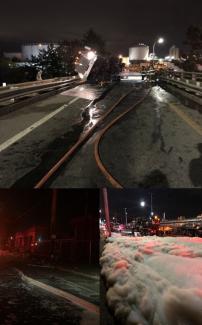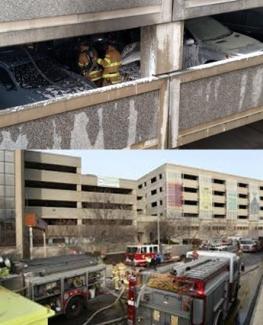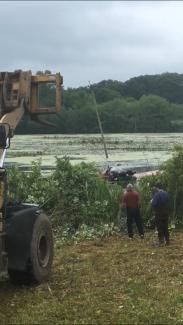Major Emergency Response Incidents

On October 3, 2018, a tanker truck rolled over on the I-95 north bound ramp off of Allens Avenue in Providence, RI. The truck was carrying 11,500 gallons of gasoline, and all but approximately 400 gallons were released into the surrounding area! Contaminated areas included a stream connected to the Providence River, grass bordering the east side of the street and the storm drain system discharging directly into the Providence River. Remediation efforts lasted several days, and extremely high levels of gasoline vapors were present in the storm drain system following the spill. These hazardous levels reached higher than 99% of the lower explosive limit (LEL), meaning the air was capable of combustion. Over 6,000 gallons of firefighting foam, water and gasoline were pumped out of the underground line beneath Allens Avenue, and a total of 17,900 gallons was collected throughout the entire cleanup process.

On January 4, 2019, a fire started in a parking garage at the T.F. Green Airport in Providence, RI. Multiple cars on the third floor erupted in flames, and gasoline combusted as well. Firefighting foam and water runoff travelled into storm drains located near the garage and required removal. 5 gallons of concentrated firefighting foam was used to completely extinguish the fire. A total of 650 gallons of firefighting foam, water and gasoline was collected throughout the entire cleanup process!
On January 19, 2019, an oil tank located at a residence in Tiverton, RI 240 gallons of heating oil into the house and surrounding environment! The oil was released leaked approximately through an open valve and spread great distances, eventually reaching a storm drain that discharged into a pond across the street. Absorbents were placed in these two areas to collect runoff oil. The tank was removed, and a significant amount of contaminated soil was excavated in an effort to remediate the large oil release. The damage and remediation efforts can be seen in the images.


On June 22, 2019, a passenger plane experienced a power failure while attempting to land at the Lincoln Airport. As a result, the plane crashed into a swamp located in the outskirts of the airport. The pilot exited the aircraft and trekked across the full length of the swamp to reach safety, avoiding any major injuries. Unaware of how much aviation fuel was present in the plane upon arrival, absorbent was placed around the aircraft to ensure no fuel would leak and spread across the swamp during the challenging and strenuous removal process. The plane was eventually pulled out of the swamp (as seen on the left), and no environmental damages were inflicted.
On March 20, 2019, a DEM emergency responder travelled to a scene located on Pine Street in Pawtucket, RI. Upon arrival, the responder discovered a large, unoccupied warehouse littered with unknown substances and ample debris. 9 chemical drums filled with unknown liquids were found near storm drains, displaying evidence of contamination to the surrounding ground. It was certainly feasible that the oily substances seeped into the storm drain, potentially posing an environmental threat. In addition to those drums, the main courtyard (as seen in the image) contained many large piles of assorted solid waste, multiple additional drums, and 5 pallet mounted totes which appeared to release unknown materials due to vandalization. The unknown substances were reported to be old beer and liquor, but the consistency of the substances did not align with those reports.

On February 9, 2019, a DEM emergency responder was notified by Rhode Island Hospital of a potential mercury exposure. It was discovered that, twelve days prior, the patient melted down old silver and gold dental fillings resulting in a release of toxic mercury levels. Consequently, the patient suffered respiratory failure and pets at the residence were exhibiting signs of dying, some of which eventually passed. Sparking a public concern, a Lumex meter was used to detect mercury levels on the household residents’ clothing, as well as the room where the patient was located. According the National Institute of Occupational Safety and Health (NIOSH), levels of concern range from 50,000 parts per trillion (ppt), but anything above 1,000 ppt can prove alarming. Readings of the household residents reached the upper hundreds. However, the patient’s clothing reached a high of an incredible 4,000 ppt! The contaminated clothing was disposed of properly to assure the surrounding environment was not affected any further.
